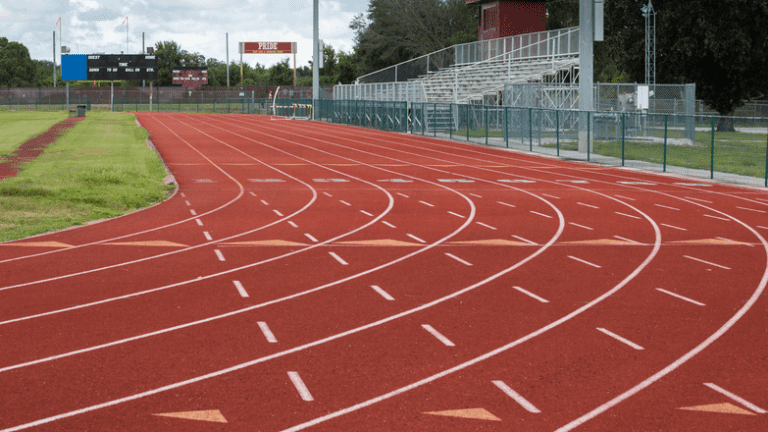Mastering the Middle Distance Events in Track & Field
It should go without saying, but the sprints are for the sprinters and the long-distance races are for the long-distance runners. A sprinter will (rarely) jump from the 100-meter dash to the 3200m run. There are clear-cut differences when you stand a sprinter next to a long-distance runner, that much is certain. But what about those athletes who excel in the middle distances? As you may have guessed, middle distance athletes are hybrids — those able to harness characteristics of both sprinters and LDRs (long distance runners). But what are those characteristics? And once those characteristics are defined, what type of training will help the athlete be successful?
Let’s examine it through the lens of specific distance-based races.
500m (Indoor)/400m (Outdoor)
The 500m/400m ‘run’ has, over the years, turned into a sprint, even so much that it’s been nicknamed the “Superman Sprint” as of late. The way these athletes now fly around the track is amazing to see, but it takes a lot of time, effort, and strategy to run a successful event. I love calling this event the “Superman Sprint” due to the amount exertion your body undertakes — it’s superhuman.
Athlete Characteristics
In all likelihood, Usain Bolt would be the greatest 400m runner (adding to his freakish list of accomplishments) the world would ever watch. His body type, his posture, his strength, and his stride just screams 400m. I like athletes in this event who have significant speed and strength — similar to your 200m sprinters — but also have the leg length and muscle endurance one would find in an 800m runner. If the athlete is not very tall, a strong, even strider would find success in this event as well.
Training Tips
If training in a group, the 400m/500m runners are a tricky bunch. They require the strength training needed for the sprinters, but I believe that they also benefit from the muscle endurance/aerobic capacity training needed for 800m runners. Because of this philosophy, I often have the 400m/500m runners warmup with the sprinters, then they went with the 800m/1600m runners to do half of their workout, and then I provided a small dose of speed for their own. I did this because, for my group at the time, I used these folks for alternates for my 4x200m and 4x800m relay teams. Though they would be far from ideal for the 4x800m, they would be trained enough not to lose the team’s position.
800m (Indoor)/1000m (Outdoor)
Over the years, I have fallen more and more in love with the 800m run. When it is run well, it is a beauty to watch. A good 800m run has strategy, positioning, endurance, power, and speed all wrapped in just two laps. As a coach, I also loved the training of it (though I am sure some of my past athletes wouldn’t agree!).
Athlete Characteristics
For this event, I like athletes who would fit the description of a “lean 400m runner,” if that makes sense. These athletes need to have an even stride, excellent pace, and great muscle endurance. Due to the speed needed towards the end, I like athletes who have great posture and leg turnover for the kick (the sprint at the end of the race). I like a lot of lean muscle here, so the strength training would focus much more on repetitions and short recovery than heavy weight.
Training Tips
Here is where some schools of thought will clash. When training athletes at this distance through the 1600m, I emphasize stride and cadence. We focus on it in excruciating detail during practice so that it becomes second nature during competition. First, the tempo. From working with stride coaches and shoe specialists, I have seen that getting the athlete’s cadence to around 180 beats per minute (bpm) is ideal. Hear it for yourself:
I like this because it makes an athlete realize how fast their turnover should be and going at this pace requires them to be erect, push their hips out, and run with an efficient running economy. I use it as a benchmark and the closer the athlete gets to it, the more they are improving.
Example: Boris Berian
Below is a video of Team USA Olympian Boris Berian running an 800m at an IAAF event in 2016. After you get the beat into your head, watch his race after he settles down after his first 200 meters. Boris’ stride is incredibly efficient and strong, very close to the 180bpm.
As far as other training tips, science has proven that middle distance and long distance runners need strength training in order to improve and be competitive. No longer are the days when a coach tells you to “go out and run.” However, the strength training, as stated earlier, would not be the same as training for a sprinter. We want lean muscle here, as well as more aerobic training than a 400m runner would get. These athletes train well (in my opinion) with the 1500m/1600m specialists, especially at the high school level.
1500m/1600m (Indoor)/1600m (Outdoor)
It is difficult not to consider the 1600m run as one of the most iconic races in track and field, next to the 100-meter dash. The 1500m/1600m run is filled with strategy, battling for position, monitoring pace and splits, and now including a vicious kick at the end. Again, here is where some thoughts clash- some people may not consider a 1500m/1600m run as mid-distance. I do because of the speed and strength these athletes need now, is much different training and characteristics a good 3000m/3200m runner requires. And when you get up to 5ks and 6ks, the training and needs continue to morph. So yes, in my opinion, the 1500m/1600m run is a mid-distance event.
Athlete Characteristics
The athletic profile of the 1500m/1600m strongly resembles that of an 800m athlete. Focus continues to shift from strength to muscle endurance and aerobic capacity. I like athletes who have smooth strides, are good with pacing, and are very competitive. When I think of the middle distance events, I believe it’s the 1500m/1600m event that requires the most strategy in terms of when to pass, passing outside versus inside, when to start the kick, and so on. With that being the case, I want athletes who can follow race strategy and who can be able to think while they race.
Training Tips
When coaching cross country, coaches will talk about “building a running base,” meaning that, throughout the week, a runner should be able to run a certain amount of miles comfortably. Some coaches are really big on having a high running base (‘high mileage’ coaching, typically 40+ miles a week), and some are flipping the thought to low running bases (‘low mileage’ coaching, between 10-30 miles a week). It really depends on the athlete on which type works for them. In my program, typically the low-mileage athlete does better because of my emphasis on short recovery, speed, and power.
With that being said, I do encourage my athletes to build a running base that is comfortable for them, and then we will tweak where needed. For 1500m/1600m and above, it is necessary to log in miles. It builds the aerobic capacity and will make the athlete a better 1500m/1600m athlete.
Though we are de-emphasizing strength training, it is still necessary for these athletes. For example, if the athlete is logging 35 miles/week with no strength training, they are putting themselves in danger of calf, ankle, or hip injuries. Building up strength in those areas makes sure their body is able to handle those miles.
Example: Jenny Simpson
For more than a few reasons, Jenny Simpson is one of my favorite runners to watch. She has a strong stride (close to the 180bpm as mentioned before), good posture, and great speed. You can tell that she and her coach worked out a nice race strategy for her in this 2013 IAAF 1500m event. It’s so well executed that you can identify each portion with certainty: stay towards the beginning of the group, move outside when you can, keep your position, and, finally, towards the end, don’t worry about being passed until the last 300m.
Conclusion
There are many different coaching philosophies when it comes to nurturing and training the middle distance athlete — and not one single recipe is going to work for every single athlete. Before any training starts, it is important to assess the athlete and see if the type of training you like to do will help the athlete improve. See their weak areas and take note of what training they love to do — this allows practice and training to be fun.
The middle distance athlete can take on many shapes and sizes, but these observations are only what I’ve seen work and what I like to do. Get out there, and start training!
How useful was this post?
Click on a star to rate it!
Average rating 4.8 / 5. Vote count: 5
No votes so far! Be the first to rate this post.




